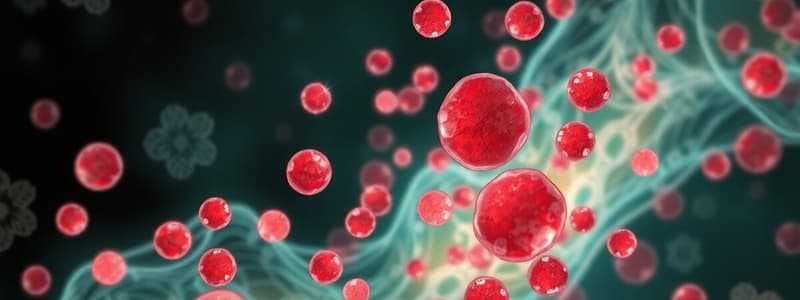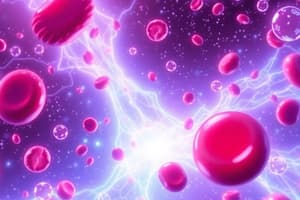Podcast
Questions and Answers
In Heparin-Induced Thrombocytopenia (HIT), what initiates the formation of immune complexes?
In Heparin-Induced Thrombocytopenia (HIT), what initiates the formation of immune complexes?
- Direct binding of heparin to FcyRlla receptors.
- Direct activation of platelets by heparin.
- Complement activation on the platelet surface.
- Heparin-mediated conformational change of platelet factor 4 (PF4), followed by IgG binding. (correct)
Which of the following is a paradoxical clinical manifestation of Heparin-Induced Thrombocytopenia (HIT)?
Which of the following is a paradoxical clinical manifestation of Heparin-Induced Thrombocytopenia (HIT)?
- Severe thrombocytopenia leading to spontaneous bleeding.
- A hypercoagulable state leading to thrombotic events. (correct)
- Disseminated intravascular coagulation (DIC).
- Marked increase in platelet count.
What is the primary mechanism by which platelets are cleared in Immune Thrombocytopenic Purpura (ITP)?
What is the primary mechanism by which platelets are cleared in Immune Thrombocytopenic Purpura (ITP)?
- Platelet aggregation and consumption in the microvasculature.
- Phagocytosis of antibody-coated platelets by splenic macrophages. (correct)
- Direct lysis of platelets by complement.
- Inhibition of platelet production by the bone marrow.
A deficiency in which metalloprotease is the primary cause of Thrombotic Thrombocytopenic Purpura (TTP)?
A deficiency in which metalloprotease is the primary cause of Thrombotic Thrombocytopenic Purpura (TTP)?
Which of the following is a key clinical manifestation included in the 'FAT RN' pentad associated with Thrombotic Thrombocytopenic Purpura (TTP)?
Which of the following is a key clinical manifestation included in the 'FAT RN' pentad associated with Thrombotic Thrombocytopenic Purpura (TTP)?
In Essential Thrombocythemia (ET), what is the most common genetic mutation that leads to the overproduction of platelets?
In Essential Thrombocythemia (ET), what is the most common genetic mutation that leads to the overproduction of platelets?
Which of the following disorders is characterized by abnormal platelets that lead to bleeding despite a high platelet count?
Which of the following disorders is characterized by abnormal platelets that lead to bleeding despite a high platelet count?
What is the significance of finding schistocytes on a peripheral blood smear?
What is the significance of finding schistocytes on a peripheral blood smear?
Which disorder is characterized by platelet activation and consumption leading to thrombosis?
Which disorder is characterized by platelet activation and consumption leading to thrombosis?
Which of the following is a typical clinical manifestation of Immune Thrombocytopenic Purpura (ITP)?
Which of the following is a typical clinical manifestation of Immune Thrombocytopenic Purpura (ITP)?
Which of the following conditions is associated with a high risk of microvascular thrombosis?
Which of the following conditions is associated with a high risk of microvascular thrombosis?
In which of the following conditions is bleeding uncommon despite low platelets?
In which of the following conditions is bleeding uncommon despite low platelets?
What is the underlying cause of the increased risk of thrombosis in Essential Thrombocythemia (ET)?
What is the underlying cause of the increased risk of thrombosis in Essential Thrombocythemia (ET)?
A patient presents with thrombocytopenia, microangiopathic hemolytic anemia, and neurological symptoms. Which of the following conditions is most likely?
A patient presents with thrombocytopenia, microangiopathic hemolytic anemia, and neurological symptoms. Which of the following conditions is most likely?
Which of the following features differentiates acute ITP from chronic ITP?
Which of the following features differentiates acute ITP from chronic ITP?
Which laboratory finding is most consistent with Essential Thrombocythemia (ET)?
Which laboratory finding is most consistent with Essential Thrombocythemia (ET)?
A patient with a history of heparin use develops thrombocytopenia. What is the most appropriate initial step in managing this patient?
A patient with a history of heparin use develops thrombocytopenia. What is the most appropriate initial step in managing this patient?
Which of the following mechanisms contributes to the formation of thrombi in HIT?
Which of the following mechanisms contributes to the formation of thrombi in HIT?
Which feature is LEAST likely to be associated with Immune Thrombocytopenic Purpura (ITP)?
Which feature is LEAST likely to be associated with Immune Thrombocytopenic Purpura (ITP)?
In differentiating between Essential Thrombocythemia (ET) and another myeloproliferative neoplasm, which genetic mutation is LEAST likely to be found?
In differentiating between Essential Thrombocythemia (ET) and another myeloproliferative neoplasm, which genetic mutation is LEAST likely to be found?
Flashcards
HIT Cause
HIT Cause
Immune reaction to heparin, forming IgG antibodies against heparin-platelet factor 4 (PF4).
HIT Pathophysiology
HIT Pathophysiology
Heparin binds PF4, IgG binds the complex, activating platelets and causing thrombin generation and consumption.
HIT Clinical Manifestations
HIT Clinical Manifestations
Thrombocytopenia, venous/arterial thromboses (DVT, PE, stroke, MI), uncommon bleeding despite low platelets.
ITP Cause
ITP Cause
Signup and view all the flashcards
ITP Pathophysiology
ITP Pathophysiology
Signup and view all the flashcards
ITP Clinical Manifestations
ITP Clinical Manifestations
Signup and view all the flashcards
TTP Cause
TTP Cause
Signup and view all the flashcards
TTP Pathophysiology
TTP Pathophysiology
Signup and view all the flashcards
TTP Clinical Manifestations
TTP Clinical Manifestations
Signup and view all the flashcards
ET Cause
ET Cause
Signup and view all the flashcards
ET Pathophysiology
ET Pathophysiology
Signup and view all the flashcards
ET Resulting Complications
ET Resulting Complications
Signup and view all the flashcards
Study Notes
Heparin-Induced Thrombocytopenia (HIT)
- HIT is characterized by the immune system reacting to heparin, especially when it is unfractionated
- IgG antibodies form against the heparin-platelet factor 4 (PF4) complex
- Heparin binds to PF4, causing a conformational change and neoepitope formation
- IgG then binds to this complex, creating immune complexes
- FcγRIIa receptors on platelets bind to the IgG, which leads to platelet activation
- The process results in substantial thrombin production, platelet aggregation, and consumption
- HIT paradoxically induces a hypercoagulable state despite causing thrombocytopenia
- Clinical signs include a drop in platelets by ≥50%
- Venous and arterial thromboses such as DVT, PE, limb ischemia, stroke, and MI can occur
- Bleeding is uncommon
Immune Thrombocytopenic Purpura (ITP)
- ITP is an autoimmune disorder typically seen post-viral in children or as a chronic condition in adults
- Antibodies (IgG) target platelet membrane antigens, such as GPIIb/IIIa
- Splenic macrophages clear antibody-coated platelets
- This action leads to increased platelet destruction and inhibited platelet production
- Sudden onset of petechiae, purpura, and mucosal bleeding are clinical signs
- Isolated thrombocytopenia with normal lab results is typical in ITP
- Acute ITP is more common in children, while chronic ITP is more common in adults
Thrombotic Thrombocytopenic Purpura (TTP)
- TTP is caused by a deficiency of ADAMTS13, the metalloprotease responsible for cleaving large vWF multimers
- Large vWF multimers promote platelet aggregation in the microvasculature
- Formation of microthrombi leads to thrombocytopenia and ischemic damage
- Clinical signs include fever, anemia (microangiopathic hemolytic – schistocytes), thrombocytopenia, renal dysfunction and neurologic symptoms
Comparison of HIT, ITP, and TTP causes
- HIT is caused by an immune reaction to heparin exposure
- ITP is caused by an autoimmune response, often post-viral
- TTP is caused by deficiency in ADAMTS13
Comparison of HIT, ITP, and TTP mechanisms
- HIT involves platelet activation and consumption
- ITP involves platelet destruction by splenic macrophages
- TTP involves microthrombi formation because of unregulated vWF
Comparison of HIT, ITP, and TTP thrombosis risk
- There is a high risk of thrombosis in HIT
- There is a low risk of thrombosis in ITP
- There is a high (microvascular) risk of thrombosis in TTP
Comparison of HIT, ITP, and TTP bleeding risk
- There is a low risk of bleeding in HIT
- There is a high risk of bleeding in ITP
- There is a moderate risk of bleeding in TTP
Comparison of HIT, ITP, and TTP key clinical signs
- HIT presents with thrombocytopenia and thrombosis
- ITP presents with petechiae, purpura, and mucosal bleeding
- TTP presents with fever, anemia, thrombocytopenia, renal and neurological signs
Comparison of HIT, ITP, and TTP peripheral smear results
- HIT shows a decrease in platelets, otherwise normal
- ITP shows a decrease in platelets with normal morphology
- TTP shows schistocytes and a decrease in platelets
Essential Thrombocythemia (ET)
- ET is a primary chronic myeloproliferative neoplasm
- Mutations in genes such as JAK2 (60%), CALR (20%), or MPL (3%) are responsible
- The mutated JAK2 pathway causes overproduction of platelets from megakaryocytes, independently of thrombopoietin (TPO) stimulation
- The condition involves clonal proliferation of megakaryocytes in bone marrow
- Platelets may be abnormal and more prone to causing thromboses
- Thrombosis (DVT, PE, stroke) can result
- Hemorrhage can result, despite the high platelet count as abnormal platelets lead to bleeding
- Splenomegaly can develop due to sequestration
- Typically diagnosed between ages 50–60
- Platelet count is >450 x 10⁹/L
- Bone marrow shows megakaryocyte hyperplasia
- May be asymptomatic or present with thrombotic/bleeding events
ET (Essential Thrombocythemia) Pathophysiology
- Involves clonal megakaryocyte proliferation resulting in increased thrombogenic platelets
ET (Essential Thrombocythemia) Thrombosis Risk
- Involves a high risk of arterial and venous thromboses
ET (Essential Thrombocythemia) Bleeding risk
- There is a present risk (despite high platelets)
ET (Essential Thrombocythemia) Key clinical signs
- Often asymptomatic or with thrombosis/bleeding events
ET (Essential Thrombocythemia) Peripheral smear
- Peripheral smear shows an increase in platelets and megakaryocyte hyperplasia in bone marrow
Studying That Suits You
Use AI to generate personalized quizzes and flashcards to suit your learning preferences.





